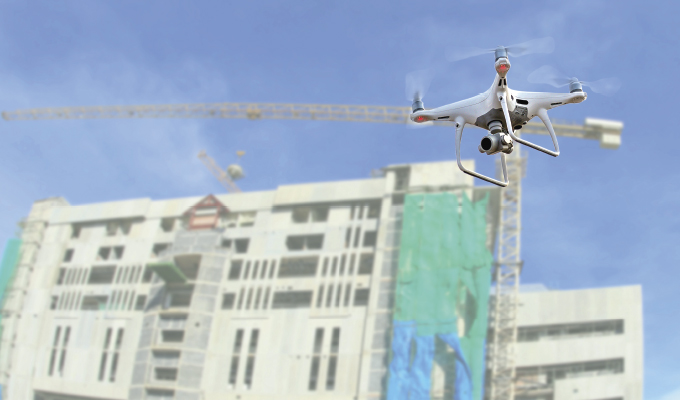Drones have become invaluable for collecting data from the hardest-to-reach places on a jobsite.
Recent technological advancements have made drones, or unmanned aerial vehicles (UAVs), easier to use. This evolution has reduced their costs while increasing the level of the data they capture—similar to the introduction and increased use of laser scanners.
According to the Federal Aviation Administration (FAA), more than 314,600 commercial drones are registered in the United States. The number continues to grow.
Contractors have started to use drones to generate accurate orthophotos, 3D models, and high-density point clouds. This is a great start, but the use of drones can be incorporated into every step of a jobsite’s process, from the earliest site preparation and planning phase to ongoing build verification to the final stages of a commissioning handover.
Drones regularly deliver better and more detailed data in a fraction of the time needed by ground-based scanners. This rapid data collection allows companies to simplify their workflow and leverage vast amounts of data to make actionable decisions.
CAPTURE DETAILED DATA
Because of their versatility, drones are helpful in both new and existing projects. They can quickly and safely capture the data needed to track progress on projects of any size.
Manually capturing data for a modest-size, multi-story building could take workers the better part of a day, and they still won’t be able to capture data in places that are too costly or too dangerous to send crews.
By comparison, a drone can capture hundreds of thousands of data points per second and millions of data points in a matter of hours, giving project managers the insight into a project’s progress they need to track against plans. Such an incredible amount of data provides a complete view of a project, eliminating any guesswork and ensuring that all decisions are based on facts.
Once teams capture the data, they can integrate it with many software platforms used on the jobsite or share it with colleagues off-site. And as jobs advance, drones are ideally suited to capture additional data needed to track progress.
Additionally, teams can automate the process. In doing so, they could program a drone to automatically capture data regularly—as frequently as a job demands updated information.
Using Simultaneous Location and Mapping (SLAM) spatial awareness technology, the drone collects data to map its environment. The SLAM technology, integrated into a solution’s Visual Inertial System (VIS), leads to a more complete data capture, making the operation less manually focused, which reduces the risk of human error. Combined with onboard RTK GNSS positioning, drone data is quickly georeferenced with other measured site data.
Drones are ideally suited to work in tandem with other manual processes employed on some jobsites. They are solving once very complex workflows with an incredibly simple solution that meets the need of the customer.
DRONES HAVE EVOLVED
When drones first entered the construction space, companies generally envisioned that every project manager would have a drone at their disposal. It would be used when needed to capture data and check on a site’s progress.
Over time, many changed their approach, and dedicated, highly specialized drone teams were created instead of training all project managers on staff. These special teams would go from one project to another to capture data as needed and share it with a project manager.
But the deployment and use of drones is changing once again. The industry is now seeing its initial vision becoming a reality; companies don’t need to have highly specialized operators within their organization to use drones effectively. The simplicity that new technologies have brought to drones makes it easier for a range of workers on a jobsite to pilot them and download the necessary data. That said, while drones are increasingly easier to use, deploying them still has some limitations.
Consider that the United States has a healthy set of regulations governing drone operations, including where they can be operated. Drone operators must be certified and earn their UAS pilot’s certificate.
TOMORROW’S JOBSITE
Contractors should look at technology with an eye toward the future. The jobsite of tomorrow will be autonomous; deploying technology such as drones will help companies prepare for these inevitable changes.
The pandemic and the ongoing labor shortage alone didn’t push contractors to adopt and deploy more onsite technology. The jobsite has been moving toward technology for years, and the pandemic proved how these technology-enabled tools could help contractors weather and navigate uncertainties.
The broader use of onsite technology is significant because of its positive impact on many elements of the jobsite, from productivity to safety. Contractors should no longer look at technology such as drones as another tool in their toolbox; they should look at technology as a professional partner that enables them to drive their business forward.
CLOSING THOUGHT
Drones have the power to potentially spot problems early and save companies money. As companies continue to rebound from the pandemic and navigate new challenges—from inflation to higher gas prices—saving time, resources, and ultimately money become ever more critical.
About the Author:
Travis Rauscher is business development director UAS at Hexagon Geosystems. His background is in civil engineering, heavy construction, and multifamily housing. He has been in the industry for 15 years, joining Hexagon in March 2021. Rauscher has his Part 107 certificate and has been flying and utilizing UAVs over the past 8 years.
Bryan Baker is the North American UAS sales manager for Leica Geosystems Inc. He has more than 35 years of experience in the geospatial industry, focusing on sales management, software and application development, training, and technical support for land surveying, civil engineering, and GIS. Bryan is an instrument-rated, commercial pilot and certified flight instructor, along with being a field representative for the FAA Safety Team and an ASPRS certified mapping scientist.
Modern Contractor Solutions, July 2022
Did you enjoy this article?
Subscribe to the FREE Digital Edition of Modern Contractor Solutions magazine.



